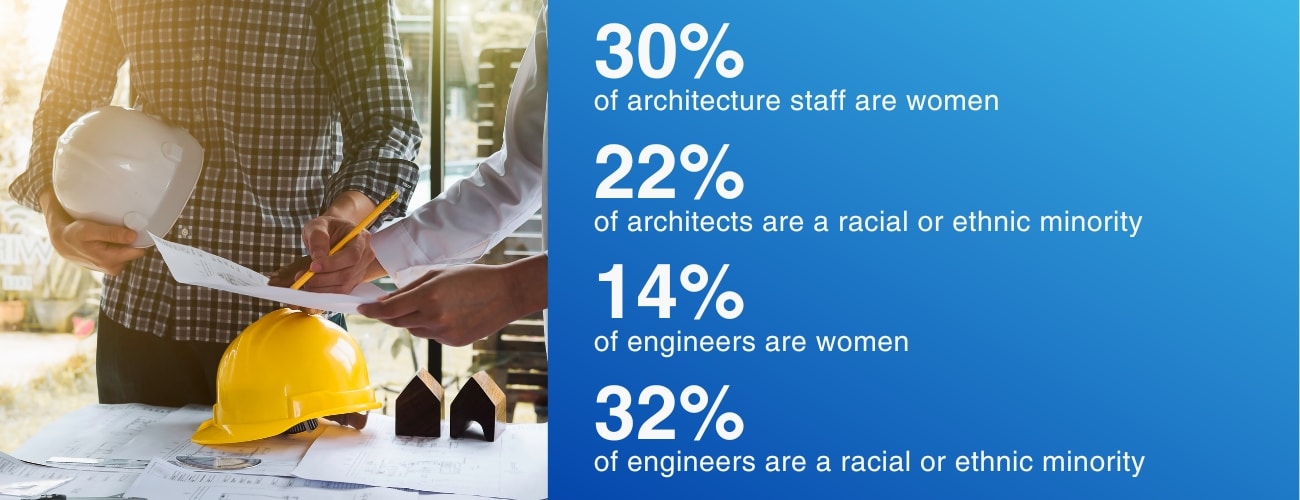February 2, 2024 8 min read

Diversity in Engineering and Architecture: How to Create a Winning Culture
Industry:
Solution:

27 percent. That’s how many women make up the architecture and engineering industry, according to 2020 BLS data. From discrimination issues to long, inflexible hours, these fields are losing female talent at a higher rate than men. At a time where the AEC industry needs more talent, this loss of knowledge, perspective, and diversity can have huge consequences. Keep reading to learn how fostering more diversity in engineering and in architecture is the secret to success—and how to get there.
The State of Diversity, Equity, and Inclusion (DEI) in AEC
The sad truth is that architecture, engineering, and construction (AEC) firms struggle with diversity. From stereotypes about working in these fields to the employee experience of women and people of color, there are many challenges to overcome.

Diversity in Architecture
Picture this: across the U.S., there are roughly the same number of men and women who graduate from architecture schools. But only:
Let that sink in.
How did we get here? Experts point to a variety of reasons for this, including:
- Long hours and low pay (women face a pay gap in architecture)
- Limited flexibility (5% of architect fathers are primary caregivers compared to 44% of architect mothers)
- Lack of progressive office cultures
- Lack of opportunities to advance
- Few mentorship opportunities
It doesn’t get much better when we look at racial diversity in architecture. In 2020, only 22% of architects in the U.S. identified as a racial or ethnic minority. While that number is up from previous years, only 2% of architects are Black, which is the same as it was ten years ago.
Why is this the case? One huge barrier is the financial burden of becoming an architect, with non-white candidates being far less likely to receive financial support from their firm towards the cost of the exam.
Diversity in Engineering
Diversity in engineering is an all too similar story. The ethnicity breakdown of engineers is 67.9% White, 15% Asian, 9.1% Hispanic or Latino.
Gender diversity in engineering fields isn’t much better.
Of all the fields in STEM, engineering has the lowest proportion of women. Just 14%. Harvard Business Review claims that engineering just might be the “most male-dominated profession in the U.S.”.
Women aren’t getting as many STEM degrees, but even worse is that women are leaving the field at high rates, facing sexual harassment and discrimination at work.
If we want more diverse candidates in architecture and engineering fields, we have to change our cultures, how we hire, and how we proactively prevent employees from leaving.
Why Architecture, Engineering, and Design Firms Need to Embrace Diversity
The call for diversity in architecture and engineering isn’t just a matter of ticking boxes—it’s a strategic imperative for success. Beyond moral and ethical considerations, fostering diversity within these industries has many benefits.
1. Innovation and Creativity
Diverse teams are more innovative. A BCG survey found that companies with above-average diversity saw higher revenue from innovation and overall better financial performance.
Why? Because bringing together individuals with varied backgrounds, perspectives, and life experiences sparks more debate, creativity, and the ability to problem solve.
In architecture and engineering, where innovative problem-solving is paramount, a diverse team is better equipped to approach challenges from multiple angles, leading to groundbreaking solutions and designs.
2. Enhanced Problem-Solving
Construction projects are only becoming more complex (hello, megaprojects and Smart Buildings!). This demands a high level of problem-solving, and cognitively diverse teams are much faster at doing exactly that.
3. Client Understanding and Satisfaction
The clients you work with come from a variety of backgrounds. Diverse teams can better understand and cater to a diverse client base.
In architecture and design, where projects are often deeply connected to the communities they serve, having a team that reflects that diversity enhances the ability to connect with clients on a profound level to exceed expectations.
4. Talent Attraction and Retention
A commitment to diversity is a magnet for great engineering, architecture, and design talent.
Young professionals entering the architecture and engineering fields actively seek workplaces that embrace inclusivity and celebrate differences. By fostering diversity, firms not only attract a wider pool of talent but also create an environment where individuals feel valued and are more likely to stay and grow within the organization.
Employee Onboarding Guide for AEC Companies
Get your AEC workforce up to speed faster and increase long-term employee retention
Download Guide
5. Resilience and Adaptability
Diverse teams are inherently more resilient and adaptable. In an industry that constantly evolves with technological advancements and changing client needs, having a team that can readily adapt to new challenges and opportunities is a strategic advantage.
How to Create Company Cultures That Foster Diversity, Equity, and Inclusion
Fostering a culture of Diversity, Equity, and Inclusion (DEI) isn’t just about policies—it’s about ingraining these values into the fabric of your organization. Here are key strategies to cultivate a workplace where diversity is celebrated, equity is prioritized, and every individual feels included and belongs.
1. How to Foster Diversity
- Embrace inclusive hiring practices. Start by reevaluating your hiring processes. Ensure job postings are crafted to attract a diverse pool of candidates. Implement blind resume reviews to reduce unconscious biases, and actively seek talent from underrepresented groups.
- Include diverse perspectives in decision making. Having individuals from varied backgrounds help make choices for the company is a great way to ensure innovation and hear voices across the company. This is a way to go beyond checking the diversity box and truly embrace the beauty and power of diversity.
- Support employee resource groups. Encourage the formation of Employee Resource Groups (ERGs) that cater to various identities and backgrounds. These groups provide a platform for employees to connect, share experiences, and contribute to a more inclusive workplace. But make sure you properly fund and support them, so these employees aren’t asked to do more work just to feel like they have a voice.
2. How to Create Equity for Employees
- Conduct pay equity audits. Regularly review and audit your organization’s pay structure to identify and address any gender or ethnicity-based pay gaps. Transparency in compensation practices fosters a sense of equity and fairness among employees.
- Provide equal access to opportunities. Ensure that all employees have equal access to opportunities for professional development, mentorship, and career advancement. A level playing field empowers individuals to grow within the organization regardless of background.
- Support flexibility when possible. Recognize and accommodate diverse needs by offering flexible work arrangements. Whether it’s remote work options, flexible hours, or compressed workweeks, creating flexibility enhances equity and supports a more inclusive workplace.
3. How to Practice Inclusion
- Lead from the top. Leadership sets the tone for inclusion. Train leaders to be mindful of diversity and to create an environment where every voice is heard. Inclusive leaders actively seek input from all team members, valuing diverse perspectives. It’s even better if you make sure to promote diverse candidates into leadership positions!
- Cultivate open communication. Establish channels for open communication where employees feel comfortable sharing their thoughts and concerns. Regular town hall meetings, anonymous suggestion boxes, or dedicated forums can serve as platforms for inclusive dialogue.
- Celebrate diverse perspectives. Recognize and celebrate cultural and religious holidays, heritage months, and other significant events. This not only acknowledges the diversity within your workforce but also fosters a sense of belonging and appreciation.
4. How to Reinforce Belonging
- Prioritize mental health support. Acknowledge the impact of mental health on overall well-being. Provide resources and support for mental health, ensuring employees feel supported and valued for their contributions.
- Establish mentorship programs. Facilitate mentorship programs that connect employees across different levels and backgrounds. Mentorship promotes a sense of belonging by fostering relationships that extend beyond immediate teams.
- Create inclusive policies. Review and update company policies to ensure they are inclusive and considerate of diverse needs. From parental leave policies to accommodation for religious practices, inclusive policies reinforce a sense of belonging for all employees.
Why Training is the Key to Promoting Stronger Diversity in AEC
If you look at some of the reasons AEC employees quit or the barriers to joining the profession in the first place, a lot of it comes back to equitable access to resources and opportunities.
That’s why it’s so important to provide ongoing training, support, and career paths for your architects and engineers equitably. And then be aware of the challenges in the industry so you can actively counteract them by providing additional support and resources to those who need them.
Want to learn how Vector Solutions can help you scale this training program? Request a demo today to see our DEI and harassment prevention training can help.










